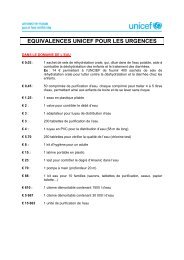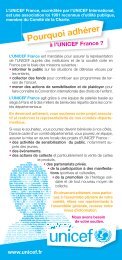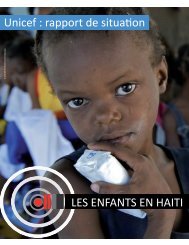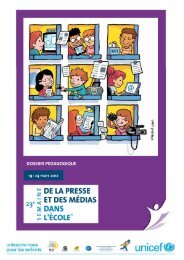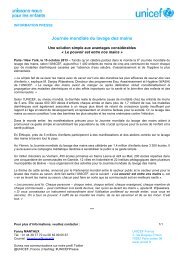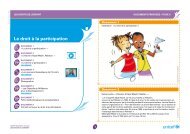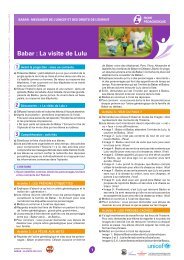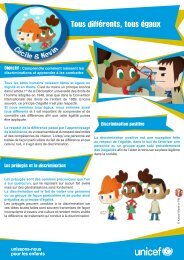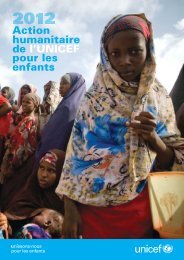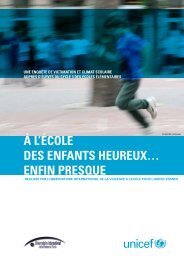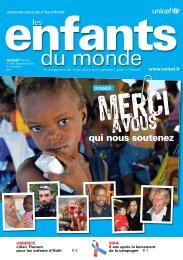La situation des enfants dans le monde 2008 - Unicef
La situation des enfants dans le monde 2008 - Unicef
La situation des enfants dans le monde 2008 - Unicef
Create successful ePaper yourself
Turn your PDF publications into a flip-book with our unique Google optimized e-Paper software.
2007, pp. 41-48; et MOST: The USAIDMicronutrient Program, Cost Analysis of theNational Vitamin A Supp<strong>le</strong>mentation Programs inGhana, Nepal, and Zambia: Synthesis of three studies,USAID, Washington, D.C., 2004, p. 4.32 Overseas Development Institute, ‘Global Health:Making partnerships work’, Briefing paper no. 15,ODI, Londres, janv. 2007, p. 1.ENCADRÉS DU CHAPITRE 4Élargissement : Une nutrition adéquate pour <strong>le</strong>smères, <strong>le</strong>s nouveau-nés et <strong>le</strong>s <strong>enfants</strong>Basic Support for Institutionalizing Child SurvivalProject, Basics II Country Report: Benin, BASICS II,Agency for International Development <strong>des</strong> États-Unis,Arlington, VA, 2004, pp. 7-15; Collins, Steve, et al.,‘Key Issues in the Success of Community-BasedManagement of Severe Malnutrition’, Food andNutrition Bul<strong>le</strong>tin, vol. 27, no. 3, 2006, pp. S49-S51;Collins, Steve, et al., ‘Management of severe acutemalnutrition in children’, The <strong>La</strong>ncet, vol. 368, no.9551, 2 déc. 2006, p. 1992; Banque mondia<strong>le</strong>,Repositioning Nutrition as Central to Development: Astrategy for large-sca<strong>le</strong> action, Banque mondia<strong>le</strong>,Washington, D.C., 2006, pp. 10-11; et Organisationmondia<strong>le</strong> de la Santé, Programme alimentaire mondial,Comité permanent <strong>des</strong> Nations Unies sur lanutrition et Fonds <strong>des</strong> Nations Unies pour l’enfance,‘Community-Based Management of Severe AcuteMalnutrition’, OMS, PAM, SCN et UNICEF, Genève,Rome, New York, mai 2007, p. 2.<strong>La</strong> « budgétisation margina<strong>le</strong> <strong>des</strong> gou<strong>le</strong>ts d’étrang<strong>le</strong>ment»Fonds <strong>des</strong> Nations Unies pour l’enfance, Banquemondia<strong>le</strong> et Organisation mondia<strong>le</strong> de la Santé, ‘AStrategic Framework for Reaching the Mil<strong>le</strong>nniumDevelopment Goals on Child Survival in Africa’, projetpréparé à la demande de l’Union africaine, 27 sept.2006, p. 25.Élargissement : eau salubre, assainissement adéquatet meil<strong>le</strong>ures pratiques d’hygièneBlack, Robert E., Saul S. Morris et Jennifer Bryce, ’Where and why are 10 million children dying everyyear?’, The <strong>La</strong>ncet, vol. 361, 28 juin 2003, p. 2227;Curtis, Val, et Sandy Cairncross, ‘Effect of WashingHands with Soap on Diarrhoea Risk in theCommunity: A systematic review’, The <strong>La</strong>ncetInfectious Diseases, vol. 3, no. 5, mai 2003, p. 275;Favin, Michael, Promoting Hygiene Behavior Changewithin C-IMCI: The Peru and Nicaragua experience,Activity Report 143, Environmental Health Project,Washington, D.C., oct. 2004, p. xi; IRC, Centre internationalde l’eau et de l’assainissement et Fonds <strong>des</strong>Nations Unies pour l’enfance, Water, Sanitation andHygiene Education for Schools, rapport publié à l’issuede la Tab<strong>le</strong> ronde d’Oxford, 24-26 janv. 2005,UNICEF et IRC, New York, p. 32; <strong>La</strong>ne, Jon, ‘Ghana,Lesotho and South Africa: Regional expansion ofwater supply in rural areas’, étude de cas extraite de‘Reducing Poverty, Sustaining Growth: What works,what doesn’t, and why – A global exchange for scalingup success’, document présenté à la conférenceintitulée Scaling Up Poverty Reduction, Shanghai, 25-27 mai 2004, Groupe de la Banque mondia<strong>le</strong>, 2004,pp. 1-10; Organisation panaméricaine de la santé,‘Rotavirus Update’, Immunization News<strong>le</strong>tter, vol. 27,no. 3, juin 2005, pp. 1-2; Slaymaker, Tom, et KarinChristiansen, ‘Community- Based Approaches andService Delivery: Issues and options in difficult environmentsand partnerships’, Overseas DevelopmentInstitute, Londres, févr. 2005, p. 26; Fonds <strong>des</strong>Nations Unies pour l’enfance, Progrès pour <strong>le</strong>s<strong>enfants</strong> : Un bilan de l’eau et de l’assainissement,Numéro 5, UNICEF, New York, sept. 2006, pp. 3, 22,30; Water and Sanitation Program, ‘Community-LedTotal Sanitation in Rural Areas: An approach thatworks’, WSP, New Delhi, févr. 2007, pp. 4, 6-9.<strong>La</strong> crise du personnel de santé en Afrique : il esturgent d’intervenirLes effectifs sanitaires en Afrique, Difficultés et perspectives,‘ A Report of the Africa Working Group ofthe Joint Learning Initiative on Human Resources forHealth and Development’, sept. 2006, p. 3; Équipe 4du Projet Objectifs du Millénaire sur la santé maternel<strong>le</strong>et infanti<strong>le</strong>, Who’s Got the Power? Transforminghealth systems for women and children, Earthscan,Londres, 2005, p. 77; Organisation mondia<strong>le</strong> de laSanté, ‘Guide to Health Work-Force Development inPost- Conflict Environments’, OMS, Genève, 2005,pp. 6-13, 52- 77, 119-122; Organisation mondia<strong>le</strong> dela Santé, ‘Working together for health’, Rapport sur lasanté <strong>dans</strong> <strong>le</strong> <strong>monde</strong> 2006, OMS, Genève, 2006.Les arguments en faveur <strong>des</strong> investissementspour la survie de l’enfant et <strong>le</strong>s Objectifs duMillénaire pour <strong>le</strong> développement liés à la santéen Afrique subsaharienneFonds <strong>des</strong> Nations Unies pour l’enfance, Banquemondia<strong>le</strong> et Organisation mondia<strong>le</strong> de la Santé, ‘AStrategic Framework for Reaching the Mil<strong>le</strong>nniumDevelopment Goals on Child Survival in Africa’, projetpréparé à la demande de l’Union africaine, 27 sept.2006, pp. 5-6, 38-43.P<strong>le</strong>ins feux sur <strong>le</strong> Botswana : étendre la préventionet <strong>le</strong> traitement du VIH à travers <strong>des</strong> partenariatscommunautairesRapport d’activité du Botswana, ‘A World Fit forChildren 2007’, Gouvernement du Botswana, juil<strong>le</strong>t2007, pp. 11- 12, 15, 18; Kak, Lily, et al., ‘Preventionof Mother-to- Child transmission of HIV/AIDSProgrammes’, Chapitre 7, Opportunities for Africa’sNewborns, Partnership for Maternal, Newborn &Child Health, Cape Town, 2006, pp. 113-127; etFonds <strong>des</strong> Nations Unies pour l’enfance, Progrèspour <strong>le</strong>s <strong>enfants</strong> : Bilan statistique, Numéro 6, UNI-CEF, New York, déc. 2007, pp. 30, 34, 60.Renforcer la transparence et la gouvernance de laprestation <strong>des</strong> services de santéBanque mondia<strong>le</strong>, Rapport 2004 sur <strong>le</strong> développement<strong>dans</strong> <strong>le</strong> <strong>monde</strong> : Des services pour <strong>le</strong>s pauvres,Banque mondia<strong>le</strong>, Washington, D.C., 2003, pp. 133-156.Financement en fonction de la performance auRwandaSekabaraga, Claude, Louis Rusa et Agnes Soucat,’What it Takes to Sca<strong>le</strong> up for Better Health: Theexperience of Rwanda 2004-2007’, Background paperto ‘Innovations in service delivery’, 2007.P<strong>le</strong>in feux sur <strong>le</strong> Brésil : créer un réseau nationalde systèmes de santé gérés par <strong>le</strong>s communautésFonds <strong>des</strong> Nations Unies pour l’enfance, The State ofBrazil’s Children 2006: The right to survival and development,UNICEF, Brasilia, 2005, pp. 10-11.Un nouveau mode de collaboration pour <strong>le</strong>s institutionsmultilatéra<strong>le</strong>sFonds <strong>des</strong> Nations Unies pour l’enfance, ‘InformalMeeting of Global Health Leaders: Final summary’,UNICEF, New York, juil<strong>le</strong>t 2007.CHAPITRE 51 Projet Objectifs du Millénaire (Nations Unies),Investir <strong>dans</strong> <strong>le</strong> développement : Plan pratique deréalisation <strong>des</strong> Objectifs du Millénaire pour <strong>le</strong>développement, Earthscan, Londres, 2005, pp. 1-2.2 Fonds <strong>des</strong> Nations Unies pour l’enfance, <strong>La</strong> <strong>situation</strong><strong>des</strong> <strong>enfants</strong> <strong>dans</strong> <strong>le</strong> <strong>monde</strong> 2005 : L’enfanceen péril, UNICEF, New York, 2004, pp. 57-58; UNI-CEF, Les <strong>enfants</strong> touchés par <strong>le</strong>s conflits armés :actions de l’UNICEF, mai 2002, p. 15; et UNICEF,Outlook Special Edition: Crisis in Midd<strong>le</strong> East, août.2006, p. 2.3 Extrait de : Département <strong>des</strong> Nations Unies <strong>des</strong>affaires économiques et socia<strong>le</strong>s, Bases de donnéesde la Division de la population, Perspectivesdémographiques mondia<strong>le</strong>s : la révision de 2006 etPerspectives d’urbanisation <strong>dans</strong> <strong>le</strong> <strong>monde</strong> : larevision 2005, , consulté<strong>le</strong> 30 sept. 2007.4 Organisation mondia<strong>le</strong> de la Santé, Rapport 2006sur la santé <strong>dans</strong> <strong>le</strong> <strong>monde</strong> : Travail<strong>le</strong>r ensemb<strong>le</strong>pour la santé, OMS, Genève, 2006, p. 119; Sines,Erin, Anne Tinker et Julia Ruben, ‘The Maternal-Newborn-Child Health Continuum of Care: A col<strong>le</strong>ctiveeffort to save lives’, Policy Perspectives onNewborn Health, Save the Children and PopulationReference Bureau, Washington, D.C., mars 2006,pp. 2-3.5 Juma, Ca<strong>le</strong>stous, et Lee Yee-Cheong, ‘ReinventingGlobal Health: The ro<strong>le</strong> of science, technology, andinnovation’, The <strong>La</strong>ncet, vol. 365, no. 9464, 19mars 2005, pp. 1105-1106; Acharya, Tara, AbdallahS. Daar et Peter A. Singer, ‘Biotechnology andthe UN’s Mil<strong>le</strong>nnium Development Goals’,Nature Biotechnology, vol. 21, no. 12, déc. 2003,pp. 1434-1436.6 Department of Essential Health Technologies,Organisation mondia<strong>le</strong> de la Santé, ‘Strategy for2004- 2007: eHealth for health-care delivery’,OMS, Genève, 2004, p. 2.7 Projet Objectifs du Millénaire (Nations Unies),Investir <strong>dans</strong> <strong>le</strong> développement : Plan pratique deréalisation <strong>des</strong> Objectifs du Millénaire pour <strong>le</strong>développement, Earthscan, Londres, 2005, p. 240;Nations Unies, Objectifs du Millénaire pour <strong>le</strong>développement Rapport 2007, ONU, New York,juin 2007, p. 28.8 Nations Unies, Rapport 2005 sur la <strong>situation</strong> socia<strong>le</strong><strong>dans</strong> <strong>le</strong> <strong>monde</strong> : <strong>La</strong> crise de l’inégalité, ONU, NewYork, 2005, p. 114.9 Nations Unies, Rapport 2007 sur <strong>le</strong>s Objectifs duMillénaire pour <strong>le</strong> développement, ONU, NewYork, juin 2007, p. 28.10 Gautum, Kul C., ‘Pre-Conference Report onDiseases of Poverty, Child Survival and MDGs’,présenté lors de BioVision 2007, Conférencepréparatoire sur la maladie et la pauvreté, Lyon,France, 12 mars 2007.11 Nations Unies, Rapport 2007 sur <strong>le</strong>s Objectifs duMillénaire pour <strong>le</strong> développement, ONU, NewYork, juin 2007, p. 29.12 Martines, Jose, et al., ‘Neonatal Survival: A call foraction’, The <strong>La</strong>ncet, vol. 365, no. 9465, 26 mars2005, pp. 1193-1194.13 Buse, Kent, et Andrew M. Harmer, ‘Seven Habitsof Highly Effective Global Public-Private HealthPartnerships: Practice and potential’, SocialScience & Medicine, vol. 64, no. 2, janv. 2007,p. 261.ENCADRÉ DU CHAPITRE 5Renforcer la col<strong>le</strong>cte <strong>des</strong> données et <strong>le</strong> suivi pourprendre <strong>des</strong> décisions en matière de santé publiqueFonds <strong>des</strong> Nations Unies pour l’enfance, Progrèspour <strong>le</strong>s <strong>enfants</strong>: Un <strong>monde</strong> digne <strong>des</strong> <strong>enfants</strong> bilanstatistique, Numéro 6, UNICEF, New York, déc. 2007,p. 68; Health Metrics Network, Framework andStandards for Country Health Information Systems,2nd ed., OMS, Genève, 2007, pp. 5, 17, 60.108 LA SITUATION DES ENFANTS DANS LE MONDE <strong>2008</strong>



